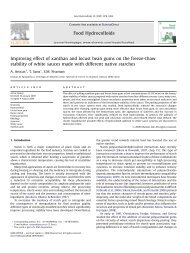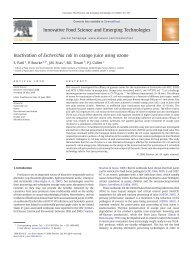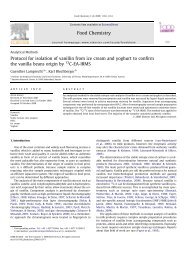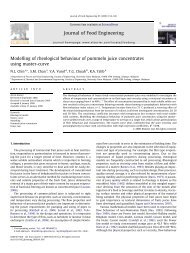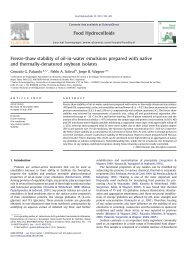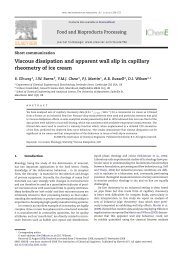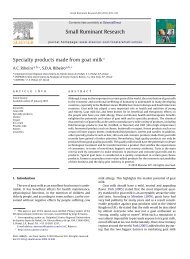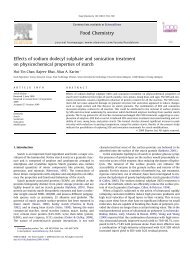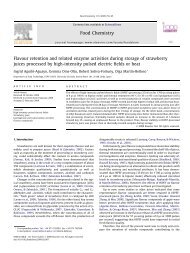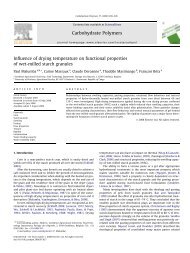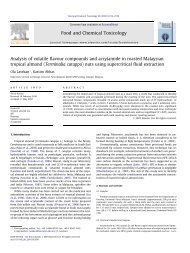Rheology and microstructure of cross-linked waxy maize starch ...
Rheology and microstructure of cross-linked waxy maize starch ...
Rheology and microstructure of cross-linked waxy maize starch ...
Create successful ePaper yourself
Turn your PDF publications into a flip-book with our unique Google optimized e-Paper software.
<strong>Rheology</strong> <strong>and</strong> <strong>microstructure</strong> <strong>of</strong> <strong>cross</strong>-<strong>linked</strong> <strong>waxy</strong> <strong>maize</strong> <strong>starch</strong>/whey protein<br />
suspensions<br />
H. Vu Dang a , C. Loisel a, *, A. Desrumaux a,1 , J.L. Doublier b<br />
a Laboratoire GEPEA, ENITIAA rue de la Géraudière, BP 82225, 44322 Nantes Cedex 3, France<br />
b INRA, UR 1628, Unité Biopolymères, Interactions, Assemblages, 44000 Nantes, France<br />
article info<br />
Article history:<br />
Received 18 July 2008<br />
Accepted 6 January 2009<br />
Keywords:<br />
Cross-<strong>linked</strong> <strong>starch</strong><br />
Whey protein<br />
Gel<br />
Rheological properties<br />
Flow properties<br />
Viscoelastic behaviour<br />
1. Introduction<br />
abstract<br />
Starch is widely used to control the structure <strong>and</strong> stability <strong>of</strong><br />
processed food products due to its thickening <strong>and</strong> gelling properties<br />
after gelatinisation. When a <strong>starch</strong>-in-water dispersion is<br />
heated above the gelatinisation temperature, <strong>starch</strong> granules loose<br />
crystallinity, absorb a large amount <strong>of</strong> water <strong>and</strong> swell up to many<br />
times their original size leading to the enhancement <strong>of</strong> viscosity.<br />
Cross-<strong>linked</strong> <strong>waxy</strong> <strong>maize</strong> <strong>starch</strong> (CWMS) is a high amylopectin<br />
<strong>starch</strong> (almost free <strong>of</strong> amylose), which has been chemically modified<br />
to make <strong>starch</strong> granules to resist to thermal <strong>and</strong> mechanical<br />
treatment. A gelatinized CWMS dispersion can be merely described<br />
as a suspension <strong>of</strong> swollen particles. These systems exhibit a shearthinning<br />
flow behaviour <strong>and</strong> a solid-like viscoelastic behaviour,<br />
these properties being mostly governed by the volume fraction <strong>and</strong><br />
the deformability <strong>of</strong> swollen <strong>starch</strong> granules depending upon<br />
* Corresponding author. Tel.: þ33 2 51 78 54 64; fax: þ33 2 51 78 54 55.<br />
E-mail address: catherine.loisel@enitiaa-nantes.fr (C. Loisel).<br />
1 Deceased on November 2006.<br />
0268-005X/$ – see front matter Ó 2009 Elsevier Ltd. All rights reserved.<br />
doi:10.1016/j.foodhyd.2009.01.004<br />
Food Hydrocolloids 23 (2009) 1678–1686<br />
Contents lists available at ScienceDirect<br />
Food Hydrocolloids<br />
journal homepage: www.elsevier.com/locate/foodhyd<br />
The objective <strong>of</strong> the present work was to investigate the effect <strong>of</strong> the heating process on the structural<br />
<strong>and</strong> rheological properties <strong>of</strong> whey protein isolate/<strong>cross</strong>-<strong>linked</strong> <strong>waxy</strong> <strong>maize</strong> <strong>starch</strong> (WPI/CWMS) blends<br />
depending upon the concentration <strong>and</strong> the <strong>starch</strong>/whey protein ratio. Starch concentration ranged from<br />
3 to 4% (w/w) <strong>and</strong> the protein content was <strong>of</strong> 0.5, 1 <strong>and</strong> 1.5% (w/w). The blend (pH 7, 100 mM ionic<br />
strength) was heated using a jacketed vessel at two pasting temperatures: 90 <strong>and</strong> 110 C. The particle size<br />
distribution <strong>of</strong> the WPI suspension (1.5%) displayed three distinct classes <strong>of</strong> aggregates (0.3, 65 <strong>and</strong><br />
220 mm), whereas the size <strong>of</strong> swollen <strong>starch</strong> granules varied from 48 to 56 mm according to the pasting<br />
temperature. When the two components were mixed together, the peak attributed to swollen <strong>starch</strong><br />
granules was attenuated <strong>and</strong> broadened towards higher values (up to 88 mm) due to protein aggregates<br />
(260–410 mm). This effect was more pronounced as the protein concentration increased. When compared<br />
to <strong>starch</strong> alone, the rheology <strong>of</strong> the mixed system was dramatically modified for the flow behaviour as<br />
well as for the viscoelastic properties which changed from a solid-like (3–4% <strong>starch</strong>) to a liquid-like<br />
behaviour (3–4% <strong>starch</strong>/1.5% protein). Microscopic observations showed aggregated proteins located in<br />
the continuous phase <strong>and</strong> swollen <strong>starch</strong> granules as the dispersed phase. Protein aggregates were <strong>of</strong><br />
different sizes, part <strong>of</strong> them appeared adsorbed onto swollen <strong>starch</strong> granules while another part was<br />
unevenly distributed in the continuous phase, yielding discontinuous network which could explain the<br />
peculiar viscoelastic behaviour <strong>of</strong> such suspensions.<br />
Ó 2009 Elsevier Ltd. All rights reserved.<br />
concentration (Evans & Haisman, 1979; Evans & Lips, 1992; Loisel,<br />
Tecante, & Doublier, 2002; Nayouf, Loisel, & Doublier, 2003; Steeneken,<br />
1989; Tecante & Doublier, 1999). It has been shown that<br />
within the pasting temperature range 90–110 C, the rheological<br />
behaviour <strong>of</strong> CWMS dispersions is dominated by the volume fraction<br />
up to 3% concentration, while above 4% concentration<br />
deformability <strong>of</strong> swollen <strong>starch</strong> granules plays a major role (Loisel<br />
et al., 2002; Nayouf et al., 2003).<br />
Apart from <strong>starch</strong>, whey protein isolates (WPI) can be employed<br />
because <strong>of</strong> their unique functional properties, i.e. gelling, thickening,<br />
foaming <strong>and</strong> water-binding capacity. These ingredients have<br />
a high protein content (>95%) in the globular state <strong>and</strong> consist<br />
mostly <strong>of</strong> b-lactoglobulin (>70% <strong>of</strong> total protein) <strong>and</strong> a-lactalbumin<br />
(15–20%). Thermal gelation <strong>of</strong> globular proteins involves an initial<br />
denaturation/unfolding step followed by aggregation to finally<br />
form a three-dimensional network provided the concentration is<br />
high enough. Aggregation <strong>of</strong> unfolded protein molecules occurs<br />
through hydrophobic <strong>and</strong>/or hydrogen interactions, <strong>and</strong> formation<br />
<strong>of</strong> disulfide bridges (Mulvihill & Kinsella, 1987). These aggregation<br />
<strong>and</strong> gelation phenomena are strongly dependent upon protein<br />
concentration, pH, type <strong>and</strong> concentration <strong>of</strong> ions present in the
aqueous phase. They have been reported to take place from 62 C<br />
for a-lactalbumin to 78 C for b-lactoglobulin in the pH <strong>and</strong> ionic<br />
conditions <strong>of</strong> milk (Bryant & Mc Clements, 1998). For b-lactoglobulin<br />
(200 g L 1 , pH 7), the denaturation temperature has been<br />
found to increase from 69.5 to 76.5 C while increasing the NaCl<br />
content from 0.5 to 2 M (Boye, Alli, & Ismail, 1996).<br />
b-Lactoglobulin has been found to form gels for concentration<br />
above 10 g L 1 in 100 mM NaCl <strong>and</strong> pH 7 (Dur<strong>and</strong>, Gimel, & Nicolai,<br />
2002). As for isolated b-lactoglobulin, the critical concentration for<br />
gelation to take place in the case <strong>of</strong> WPI heated to 90 C has been<br />
found to be 11 g L 1 (Puyol, Perez, & Horne, 2001). Increasing the<br />
ionic strength to 60 <strong>and</strong> 100 mM NaCl resulted in a lower gelling<br />
temperature for a WPI concentration ranging from 2.5 to 10% at pH<br />
6.7 (Puyol et al., 2001).<br />
In the food industry, mixed systems <strong>of</strong> proteins <strong>and</strong> polysaccharides<br />
are <strong>of</strong>ten used to improve the textural properties.<br />
Consequently, investigation <strong>of</strong> gel formation <strong>of</strong> whey protein/<strong>starch</strong><br />
mixed system has received considerable attention, particularly on<br />
the basis <strong>of</strong> rheological methods (Aguilera & Baffico, 1997; Fitzsimons,<br />
Mulvihill, & Morris, 2008; Matser & Steeneken, 1997; Okechukwu<br />
& Rao, 1997; Ravindra, Genovese, Foegeding, & Rao, 2004).<br />
The CWMS/WPI mixtures can be described as swollen <strong>starch</strong><br />
granules embedded in the continuous phase constituted by the<br />
protein network, provided the protein concentration is high<br />
enough. If no interaction occurs between these two biopolymers,<br />
the proteins are located in the intergranular phase between the<br />
<strong>starch</strong> granules. Upon heating, the whey protein concentration in<br />
the intergranular phase would increase as a result <strong>of</strong> the exclusion<br />
by swollen <strong>starch</strong> granules <strong>and</strong> the protein contributes to the<br />
properties <strong>of</strong> the continuous phase (Matser & Steeneken, 1997), as it<br />
has been suggested in the case <strong>of</strong> <strong>starch</strong>/polysaccharide mixtures<br />
(Alloncle, Lefebvre, Llamas, & Doublier, 1989; Tecante & Doublier,<br />
1999). It is then possible to calculate the effective protein concentration<br />
in the intergranular phase, from the volume fraction <strong>of</strong><br />
<strong>starch</strong> in the mixture.<br />
The aim <strong>of</strong> this study was to describe the rheological properties<br />
<strong>and</strong> the structure <strong>of</strong> a CWMS/WPI mixture at fixed pH (7) <strong>and</strong> ionic<br />
strength (100 mM) <strong>and</strong> for different CWMS/WPI ratios, for two<br />
pasting temperatures 90 <strong>and</strong> 110 C. Two <strong>starch</strong> concentrations, 3<br />
<strong>and</strong> 4%, were used. The WPI nominal concentrations (0.5, 1.0, 1.5%)<br />
were chosen in order to lie under (0.5%) or at the vicinity (1.5%) <strong>of</strong><br />
the critical gelling concentration.<br />
2. Materials <strong>and</strong> methods<br />
2.1. Materials<br />
The <strong>cross</strong>-<strong>linked</strong> <strong>waxy</strong> <strong>maize</strong> <strong>starch</strong> (CWMS, adipate <strong>cross</strong><strong>linked</strong><br />
<strong>and</strong> acetate stabilized) was supplied by Roquette Frères<br />
(Lestrem, France); the whey protein isolate WPI (Prolacta 90, 92.4%<br />
protein) was obtained from Lactalis (Laval, France).<br />
2.2. Preparation <strong>of</strong> the mixtures<br />
The WPI powder was first dispersed in demineralised water at<br />
40 C under strong mechanical stirring (1300 rpm), to obtain 0.5,<br />
1.0 or 1.5% concentration, then submitted to milder stirring<br />
conditions (300 rpm) for 1 h; the dispersion was then cooled down<br />
to 25 C. NaCl was added up to 100 mM <strong>and</strong> the pH adjusted to pH 7<br />
with 1 M NaOH; the preparation was left overnight at 4–5 C under<br />
magnetic stirring.<br />
Starch at 3 or 4% (w/w) was slurried in the WPI solution previously<br />
prepared at 0.5, 1.0, or 1.5% (w/w) at 60 C under mechanical<br />
stirring. The thermal treatment was then applied to these<br />
suspensions in a jacketed vessel (capacity 2 L, stirring rate 400 rpm)<br />
H. Vu Dang et al. / Food Hydrocolloids 23 (2009) 1678–1686 1679<br />
pre-heated at 90 or 110 C. This temperature was maintained for<br />
10 min. The suspension was then cooled down to 70 C before<br />
sampling. It is to be emphasized that the dispersion was continuously<br />
stirred during the preparation procedure. Concentrations<br />
were then controlled by weighing aliquots overnight at 102 C<br />
(accuracy <strong>of</strong> the order <strong>of</strong> 0.5%).<br />
2.3. Particle size determination<br />
Particle size determination was performed at room temperature<br />
using a Malvern Master sizer (Malvern Instrument, Ltd) with<br />
a 300 mm Fourier cell (range 0.05–879 mm) using 1.529 for the<br />
refractive index <strong>and</strong> 0.1 absorption for <strong>starch</strong> <strong>and</strong> 1.545 <strong>and</strong> 0.001<br />
for WPI respectively. The <strong>starch</strong> paste was diluted (1/10) with<br />
demineralised water, then dispersed in the sample dispersion unit<br />
(1/100 ml water) <strong>and</strong> fed into the measuring cell. From each characterization,<br />
the median volume diameter D (v, 0.5) defined as the<br />
diameter for which 50% <strong>of</strong> the particles (by volume) are larger than<br />
this value was chosen to allow comparisons with the literature<br />
(Okechukwu & Rao, 1995). When the size distribution was polydisperse<br />
as for WPI solutions or for the WPI/<strong>starch</strong> mixtures the<br />
peaks <strong>of</strong> the particle size distribution were favoured to describe the<br />
curves. The refractive index used for the mixture was the same as<br />
for <strong>starch</strong> alone. Each experiment was repeated twice with an<br />
accuracy <strong>of</strong> about 0.5%.<br />
2.4. Rheological measurements<br />
Flow <strong>and</strong> viscoelastic properties <strong>of</strong> the suspensions were<br />
measured at 60 C using a controlled stress rheometer (AR1000, TA<br />
Instruments) with the cone/plate geometry (6 cm/2 ). The exposed<br />
edge <strong>of</strong> the sample was coated with a thin layer <strong>of</strong> paraffin oil in<br />
order to minimize moisture loss during the measurements. For flow<br />
curves, an up–down shear scan from 0.01 to 300 s 1 (30 s) was<br />
applied, followed by a logarithmic stepwise decrease from 300 to<br />
0.01 s 1 after equilibrium for each shear rate. For viscoelastic<br />
measurements in oscillatory shear, the samples were subjected to<br />
a frequency scan from 40 to 0.2 rad/s at 4% strain deformation<br />
(within the linearity limits <strong>of</strong> viscoelasticity). Each experiment was<br />
repeated twice with an accuracy <strong>of</strong> about 5%.<br />
2.5. Microscopic observation<br />
2.5.1. Light microscopy<br />
Optical images were obtained on a microscope equipped with<br />
a CCD camera (Leica Microscope). The samples were diluted <strong>and</strong><br />
dyed with ‘‘Fast green FCF’’ before being observed with a magnification<br />
<strong>of</strong> 400.<br />
2.5.2. Confocal laser scanning microscopy (CLSM)<br />
CLSM was used in the fluorescent mode. Observations were<br />
made with a Carl Zeiss LSM 410 Axiovert (Le Pecq, France) using<br />
a water-immersed 40 objective. The proteins were labelled by<br />
adding 100 mL <strong>of</strong>a2gL 1 ANS (8-anilino-1-naphtalene sulphonic<br />
acid) solution to 2 mL <strong>of</strong> the mixture. The labelled solution was<br />
then treated at 95 C during 10 min, poured warm onto the slide,<br />
<strong>and</strong> then left during 24 h at ambient temperature. ANS is known<br />
to become fluorescent in the UV light when it is adsorbed onto<br />
hydrophobic zones. This allows one to observe proteins without<br />
covalently bound fluorescent labelling (Bourriot, Garnier, &<br />
Doublier, 1999). The excitation using the UV laser was performed<br />
at 364 nm <strong>and</strong> the emission was recorded between 450 <strong>and</strong><br />
497 nm.
1680<br />
2.5.3. Phase-contrast light microscopy<br />
The samples were observed without any dilution on a Nikon<br />
Eclipse E 400 microscope with a 20 objective.<br />
3. Results<br />
3.1. Particle size distributions<br />
Typical results for particle size distribution are shown in Fig.1–3.<br />
Fig. 1 shows the particle size distribution curves <strong>of</strong> the WPI solution<br />
(1.5%), the CWMS suspension (3%) <strong>and</strong> WPI/CWMS mixtures all<br />
heated to 90 C. For WPI alone, three populations were observed<br />
corresponding to three sizes <strong>of</strong> whey protein aggregates. The most<br />
important fraction was centred at around 0.3 mm. It is to be noticed<br />
that the size <strong>of</strong> the b-lactoglobulin dimer is about 6 nm. Therefore,<br />
the size <strong>of</strong> 0.3 mm is to be ascribed to protein aggregates likely owing<br />
to the association <strong>of</strong> primary aggregates as described by Mahmoudi<br />
(2007) in the same pH <strong>and</strong> ionic environment. The two other peaks<br />
were centred at w65 mm <strong>and</strong> 220 mm. They may be due to the<br />
growth or aggregation <strong>of</strong> the former aggregates into larger ones.<br />
For the 3% CWMS dispersion, there was only one peak (D (v,<br />
0.5) ¼ 48 mm), representing the swollen <strong>starch</strong> granules in agreement<br />
with previous results (D (v, 0.5), w45 mm) (Nayouf et al.,<br />
2003). The pr<strong>of</strong>ile displayed by the 0.5% WPI/3% CWMS mixture<br />
was almost superimposed to that <strong>of</strong> CWMS alone. There was no<br />
evidence <strong>of</strong> whey protein aggregates below 1 mm <strong>and</strong> the size <strong>of</strong> the<br />
swollen <strong>starch</strong> granules appeared unchanged. There was however<br />
a slight shift <strong>of</strong> the maximum <strong>of</strong> the peak from 48 to 56 mm. For the<br />
1.5% WPI/3% CWMS mixture, dramatic changes were experienced:<br />
the main peak was still centred at 56 mm but this was broadened<br />
while a shoulder appeared at around 260 mm. This could be<br />
ascribed to the presence <strong>of</strong> large protein aggregates in the same size<br />
range as for 1.5% WPI solutions alone (3rd peak). It is to be noticed<br />
that the main peak (56 mm) can be ascribed to swollen <strong>starch</strong><br />
granules as well as to protein aggregates (2nd peak centred at<br />
65 mm).<br />
Fig. 2 shows the distribution pr<strong>of</strong>iles with 4% CWMS at the same<br />
pasting temperature (90 C). The pattern exhibited by the 4%<br />
CWMS alone suspension was similar to that <strong>of</strong> the 3% CWMS<br />
suspension with a single peak at 48 mm. For the 0.5% WPI/4% CWMS<br />
mixture, a single peak was also present but this was shifted to<br />
w65 mm as previously seen for the 1.5% WPI solution alone. For the<br />
Volume Frequency (%)<br />
20<br />
18<br />
16<br />
14<br />
12<br />
10<br />
8<br />
6<br />
4<br />
2<br />
0<br />
10 -1<br />
10 -1<br />
1 10 10 2<br />
Particle diameter (µm)<br />
Fig. 1. Particle size distribution <strong>of</strong> 1.5% WPI alone ( ), 3% CWMS alone (>), 0.5%<br />
WPI/3% CWMS (,) <strong>and</strong> 1.5% WPI/3% CWMS (D) mixtures pasted at 90 C.<br />
H. Vu Dang et al. / Food Hydrocolloids 23 (2009) 1678–1686<br />
10 3<br />
Volume Frequency (%)<br />
20<br />
18<br />
16<br />
14<br />
12<br />
10<br />
8<br />
6<br />
4<br />
2<br />
0<br />
10 -1<br />
10 -1<br />
1 10 10 2<br />
Particle diameter (µm)<br />
Fig. 2. Particle size distribution <strong>of</strong> 1.5% WPI alone ( ), 4% CWMS alone (>), 0.5%<br />
WPI/4% CWMS (,) <strong>and</strong> 1.5% WPI/4% CWMS (D) mixtures pasted at 90 C.<br />
1.5% WPI/4% CWMS mixture, the pr<strong>of</strong>ile displayed some similarity<br />
to that <strong>of</strong> the 1.5% WPI/3% CWMS mixture (Fig. 1) unless the peak<br />
was centred at 88 mm <strong>and</strong> the shoulder was much more accentuated<br />
<strong>and</strong> shifted to around 300 mm.<br />
Fig. 3 shows the particle size distribution <strong>of</strong> the 1.5 WPI/3%<br />
CWMS dispersion heated to 110 C. This is compared to the 3%<br />
CWMS <strong>and</strong> the 1.5% WPI dispersions. The peak <strong>of</strong> the 3% CWMS<br />
alone dispersion was slightly shifted from 48 to 56 mm as expected<br />
(Nayouf et al., 2003). For 1.5% WPI alone, a unique peak at 220 mm<br />
was observed showing that increasing the heating temperature<br />
from 90 to 110 C dramatically modified the size distribution <strong>of</strong><br />
whey protein aggregates. The smallest aggregates (from 0.1 to<br />
1 mm) seen at 90 C completely disappeared <strong>and</strong> a unique population<br />
<strong>of</strong> about 200 mm was observed. This is in agreement with<br />
the fact that increasing the temperature enhances the denaturation<br />
rate <strong>of</strong> the WPI <strong>and</strong> consequently the size <strong>of</strong> the aggregates (Kazmierski<br />
& Corredig, 2003). For the 1.5% WPI/3% CWMS mixture, two<br />
distinct peaks centred, respectively, at 56 <strong>and</strong> 410 mm were clearly<br />
identified instead <strong>of</strong> the broad one observed at 90 C. Table 1<br />
Volume Frequency (%)<br />
20<br />
18<br />
16<br />
14<br />
12<br />
10<br />
8<br />
6<br />
4<br />
2<br />
0<br />
10 -2<br />
10 -1<br />
1 10 10 2<br />
Particle diameter (µm)<br />
Fig. 3. Particle size distribution <strong>of</strong> 1.5% WPI alone ( ), 3% CWMS alone (A) <strong>and</strong> 1.5%<br />
WPI/3% CWMS (:) mixtures pasted at 110 C.<br />
10 3<br />
10 3
summarises the overall data in terms <strong>of</strong> peak diameters obtained in<br />
1.5% WPI alone, 3 or 4% CWMS <strong>and</strong> mixed WPI/CWMS dispersions<br />
heated to 90 C or 110 C. We attempted to deconvoluate the<br />
distribution curves; unfortunately this could not be performed<br />
accurately since the populations for Figs. 1 <strong>and</strong> 2 were too close to<br />
each other. Finally, increasing <strong>starch</strong> concentration in the WPI/<br />
CWMS mixture from 3 to 4% also shifted the peaks to larger values<br />
suggesting whey protein aggregates <strong>of</strong> a larger size. From these<br />
data, it appears that the size <strong>of</strong> the swollen <strong>starch</strong> granules was<br />
mostly determined by the pasting temperature <strong>and</strong> apparently was<br />
not strongly influenced by the presence <strong>of</strong> proteins.<br />
3.2. Rheological properties<br />
All rheological measurements have been performed at the end<br />
<strong>of</strong> the cooling period at 60 C. All flow curves at 60 C in linear<br />
scales <strong>of</strong> the CWMS alone suspensions as well as <strong>of</strong> the WPI/CWMS<br />
mixtures exhibited a non-Newtonian shear-thinning behaviour<br />
with an anti-clockwise loop (‘‘anti-thixotropic’’ behaviour) (not<br />
showed). Such a behaviour has been reported for CWMS suspensions<br />
(Genovese & Rao, 2003; Nayouf et al., 2003; Tecante & Doublier,<br />
1999). This may be ascribed to a rearrangement <strong>of</strong> closepacked<br />
deformable particles under shearing to yield a higher<br />
organization <strong>of</strong> the system (Barnes, Hutton, & Walters, 1989).<br />
Therefore, adding WPI to the <strong>starch</strong> suspension did not change the<br />
anti-thixotropic character <strong>of</strong> the CWMS alone suspensions.<br />
Figs. 4, 5 <strong>and</strong> 6 show the equilibrium flow curves obtained by<br />
stepwise measurements in the presence <strong>of</strong> 3% <strong>starch</strong> pasted at<br />
90 C, 4% at 90 C <strong>and</strong> 3% at 110 C, respectively. Regarding the<br />
<strong>starch</strong> suspensions alone, the entire flow curves could be fitted<br />
using the Herschel–Bulkley model according to Eq. (1), as suggested<br />
by Evans <strong>and</strong> Haisman (1979) in the case <strong>of</strong> CWMS.<br />
s ¼ s 0 þ K _g n<br />
Where s is the shear stress (Pa), _g is the shear rate (s 1 ), s0 is the<br />
yield stress (Pa), K is the consistency index (Pa s n ) <strong>and</strong> n is the flow<br />
behaviour index. The values <strong>of</strong> the Herschel–Bulkley parameters<br />
(s0, K, n) for the different concentrations are given in Table 2.Itisto<br />
be emphasized that the equation could be applied for the whole<br />
curve in the case <strong>of</strong> CWMS, while it was only valid within the shear<br />
rate range 0.01–2 s 1 for the mixtures as explained in the following.<br />
The steady state flow curves <strong>of</strong> the mixtures exhibited a rather<br />
different pattern from the ones <strong>of</strong> CWMS alone. The shape <strong>of</strong> the<br />
curves was similar to that <strong>of</strong> CWMS within the shear rate range 2–<br />
300 s 1 but was dramatically shifted to lower shear stress values in<br />
the low shear rate range (10 2 –2 s 1 ). Therefore, the apparent<br />
viscosity <strong>of</strong> the mixtures was much lower at low shear rates (10 2 –<br />
2s 1 ) than the one <strong>of</strong> the <strong>starch</strong> CWMS suspension. The reverse<br />
was seen at high shear rate (2–300 s 1 ) particularly in Figs. 4 <strong>and</strong> 6,<br />
the apparent viscosity being higher for the mixture than for CWMS<br />
alone. As WPI concentration increased (from 0.5 to 1.5%), the<br />
Table 1<br />
Peaks (mm) <strong>of</strong> the particle size distribution for WPI, CWMS suspensions <strong>and</strong> their<br />
mixtures pasted at 90 C <strong>and</strong> 110 C.<br />
Cooking temperature ( C) CWMS WPI<br />
0% 0.5% 1.0% 1.5%<br />
90 0% – – – 0.3 65 220<br />
3% 48 56 56 56 260<br />
4% 48 65 88 88 301<br />
110 0% – – – 220<br />
3% 56 _ _ 56 410<br />
– not determined.<br />
H. Vu Dang et al. / Food Hydrocolloids 23 (2009) 1678–1686 1681<br />
(1)<br />
shear stress (Pa)<br />
10 2<br />
10 1<br />
10 0<br />
10 -1<br />
10 -2<br />
10 -1<br />
10 0<br />
decrease <strong>of</strong> apparent viscosity at low shear rate was even more<br />
pronounced. It is also evident that at low shear rate, the flow curve<br />
tends to a plateau suggesting a yield stress. However, from the<br />
shape <strong>of</strong> these flow curves, it is obvious that the Herschel–Bulkley<br />
equation is not obeyed over the entire shear rate range in the case<br />
<strong>of</strong> the mixtures. Whatsoever, it was possible to apply this equation<br />
over the range 10 2 –2 s 1 , allowing one to estimate the extrapolated<br />
yield stress <strong>of</strong> the different suspensions. The Herschel–<br />
Buckley parameters obtained in these conditions are also given in<br />
Table 2. The yield stress decreased from 2.57 Pa (3% CWMS) to<br />
10 1<br />
shear rate (s -1 )<br />
Fig. 4. Equilibrium flow curves plotted in logarithmic scales <strong>of</strong> 3% CWMS alone (A),<br />
0.5% WPI/3% CWMS (,) <strong>and</strong> 1.5% WPI/3% CWMS (D) mixtures pasted at 90 C.<br />
Measurement temperature 60 C.<br />
shear stress (Pa)<br />
10 3<br />
10 2<br />
10 1<br />
10 0<br />
10 -2<br />
10 -1<br />
10 0<br />
10 1<br />
shear rate (s -1 )<br />
Fig. 5. Equilibrium flow curves plotted in logarithmic scales <strong>of</strong> 4% CWMS alone (A),<br />
0.5% WPI/4% CWMS (,) <strong>and</strong> 1.5% WPI/4% CWMS (D) mixtures pasted at 90 C.<br />
Measurement temperature 60 C.<br />
10 2<br />
10 2<br />
10 3<br />
10 3
1682<br />
shear stress (Pa)<br />
10 2<br />
10 1<br />
10 0<br />
10 -1<br />
10 -2<br />
10 -1<br />
10 0<br />
0.68 Pa (0.5% WPI/3% CWMS) <strong>and</strong> 0.44 Pa (1.5% WPI/3% CWMS)<br />
when heated at 90 C. In case <strong>of</strong> 4% CWMS, the yield stress was<br />
dramatically lowered from 11.7 Pa for 4% CWMS alone to 1.2 Pa <strong>and</strong><br />
0.7 Pa with 0.5% WPI <strong>and</strong> 1.5% WPI, respectively. This parameter<br />
decreased from 2.6 Pa (3% CWMS) down to 0.24 Pa (1.5% WPI/3%<br />
CWMS) when the dispersions were heated at 110 C.<br />
From these overall results, it is clear that adding WPI (0.5 to<br />
1.5%) to <strong>starch</strong> suspensions dramatically modified the flow behaviour<br />
with a marked decrease <strong>of</strong> the yield stress whatever the CWMS<br />
concentration (3 or 4%) <strong>and</strong> pasting temperature (90 or 110 C).<br />
Increasing the WPI concentration from 0.5 to 1.5% lowered the yield<br />
stress slightly more. These dramatic modifications in the flow<br />
behaviour at low shear rate reflect important structural differences<br />
between the CWMS suspensions <strong>and</strong> the WPI/CWMS mixtures.<br />
In Figs. 7–9, the viscoelastic behaviour <strong>of</strong> these different<br />
suspensions is illustrated by means <strong>of</strong> the mechanical spectra (G 0<br />
<strong>and</strong> G 00 as a function <strong>of</strong> frequency) measured at 60 C. The <strong>starch</strong><br />
suspensions (3% or 4%) heated to 90 Cor110 C exhibited a solidlike<br />
behaviour with G 0 > G 00 <strong>and</strong> G 0 almost independent <strong>of</strong><br />
frequency. This is typical behaviour <strong>of</strong> <strong>cross</strong>-<strong>linked</strong> <strong>starch</strong> suspensions<br />
which is to be ascribed to close-packing <strong>of</strong> swollen <strong>starch</strong><br />
granules (Nayouf et al., 2003; Tecante & Doublier, 1999). The mere<br />
effect <strong>of</strong> increasing <strong>starch</strong> concentration from 3% to 4% has been to<br />
increase G 0 , the storage modulus, from 8 to 80 Pa when pasting at<br />
10 1<br />
shear rate (s -1 )<br />
Fig. 6. Equilibrium flow curves plotted in logarithmic scales <strong>of</strong> 3% CWMS alone pasted<br />
at 90 C(>) <strong>and</strong> 110 C(A) <strong>and</strong> 1.5% WPI/3% CWMS pasted at 90 C(6) <strong>and</strong> 110 C<br />
(:). Measurement temperature 60 C.<br />
Table 2<br />
Herschel–Bulkley constants (s0, K, n) for <strong>starch</strong> pastes <strong>and</strong> the mixtures.<br />
Pasting<br />
temperature ( C)<br />
CWMS % (w/w) WPI % (w/w) _g(s 1 ) s0 (Pa) K n<br />
90 3 0 0.01–300 2.57 0.85 0.51<br />
0.5 0.01–2 0.68 1.93 0.55<br />
1.5 0.01–2 0.44 1.66 0.68<br />
4 0 0.01–300 11.75 1.60 0.71<br />
0.5 0.01–2 1.19 8.85 0.49<br />
1.5 0.01–2 0.70 8.15 0.52<br />
110 3 0 0.01–300 2.60 0.92 0.81<br />
1.5 0.01–2 0.24 3.40 0.45<br />
H. Vu Dang et al. / Food Hydrocolloids 23 (2009) 1678–1686<br />
10 2<br />
10 3<br />
G', G'' (Pa)<br />
10 2<br />
10 1<br />
10 0<br />
10 -1<br />
10 0<br />
90 C(Figs. 7 <strong>and</strong> 9). This is related to the increase <strong>of</strong> the volume<br />
fraction occupied by swollen <strong>starch</strong> granules which is the determining<br />
parameter <strong>of</strong> the rheological properties at this pasting<br />
temperature. Increasing the temperature from 90 Cto110 C (at<br />
3% CWMS) enhanced the G 0 values from 8 to about 20 Pa (Fig. 9).<br />
This is also to be ascribed to an increase <strong>of</strong> the volume fraction<br />
occupied by swollen <strong>starch</strong> granules, as indicated by the increase <strong>of</strong><br />
the median diameter which varied from 48 to 56 mm (Table 1).<br />
Adding WPI to the <strong>starch</strong> suspension yielded a dramatic change<br />
in the viscoelastic properties <strong>of</strong> the system. This is clearly illustrated<br />
for 1.5 WPI/3% CWMS whatever the pasting temperature<br />
(90 Cor110 C) (Figs. 7 <strong>and</strong> 9) <strong>and</strong> also for 1.5 WPI/4% CWMS<br />
pasted at 90 C(Fig. 8). The solid-like behaviour <strong>of</strong> CWMS alone<br />
tends to disappear. Instead, a liquid-like behaviour with<br />
a pronounced dependency <strong>of</strong> G 0 <strong>and</strong> G 00 as a function <strong>of</strong> frequency,<br />
G 0 < G 00 at low frequency <strong>and</strong> a <strong>cross</strong>-over <strong>of</strong> G 0 (u) <strong>and</strong> G 00 (u) which<br />
was between 2 <strong>and</strong> 4 rad/s. Such mechanical spectra are reminiscent<br />
<strong>of</strong> those exhibited by macromolecular solutions. For macromolecular<br />
solutions, below the <strong>cross</strong>-over, the terminal zone is<br />
accessed with theoretical slopes <strong>of</strong> 2 for G 0 (u) <strong>and</strong> 1 for G 00 (u) while,<br />
beyond the G 0 (u) <strong>and</strong> G 00 (u) <strong>cross</strong>-over, the so-called plateau zone is<br />
accessed. It is noteworthy that slopes <strong>of</strong> 2 <strong>and</strong> 1 for G 0 (u) <strong>and</strong> G 0 (u),<br />
respectively, in the terminal zone are approached in the cases <strong>of</strong> 1.5<br />
WPI/4% CWMS at 90 C(Fig. 8) <strong>and</strong> 1.5 WPI/3% CWMS at 110 C<br />
(Fig. 9). On another h<strong>and</strong>, the plateau zone is described only in its<br />
first part. Such a rather surprising behaviour is to be paralleled with<br />
the changes in the flow properties above-described, particularly<br />
the decrease <strong>of</strong> the yield stress.<br />
All these results demonstrate that WPI/CWMS mixtures were<br />
much less structured than the <strong>starch</strong> suspensions. It is to be noticed<br />
that the mixtures were white <strong>and</strong> granulous while the CWMS<br />
suspensions appeared translucent <strong>and</strong> more homogeneous.<br />
3.3. Microscopic observations<br />
Fig. 10 shows the photomicrographs (light microscopy) <strong>of</strong> the<br />
mixtures cooked at 90 C(Fig. 10a–c) <strong>and</strong> 110 C(Fig. 10d). In these<br />
10 1<br />
angular frequency (rad/s)<br />
Fig. 7. Mechanical spectra <strong>of</strong> 3% CWMS alone (A>) <strong>and</strong> 1.5% WPI/3% CWMS (:6)<br />
mixture pasted at 90 C. Solid <strong>and</strong> empty symbols represent G 0 <strong>and</strong> G 00 , respectively.<br />
Measurement temperature 60 C.<br />
10 2
G', G'' (Pa)<br />
10 3<br />
10 2<br />
10 1<br />
10 0<br />
10 -1<br />
10 0<br />
images, only the proteins are contrasted since they have been dyed<br />
using fast Green FCF. For the 0.5% WPI/3% CWMS dispersion<br />
(Fig. 10a), the swollen <strong>starch</strong> granules were seen, their size being<br />
about 50 mm in agreement with the size determination (Fig. 1).<br />
Moreover, voids could be observed between <strong>starch</strong> granules. No<br />
large protein aggregate could be distinguished but only small dark<br />
spots suggesting the presence <strong>of</strong> proteins. At a higher protein<br />
concentration (1 <strong>and</strong> 1.5% WPI; Fig. 10b <strong>and</strong> c), large aggregates <strong>of</strong><br />
proteins appeared whose size was around 80–200 mm in accordance<br />
with the size determination (Fig. 1). For the higher pasting<br />
10 1<br />
angular frequency (rad/s)<br />
Fig. 8. Mechanical spectra <strong>of</strong> 4% CWMS alone (A>) <strong>and</strong> 1.5% WPI/4% CWMS (:6)<br />
mixture pasted at 90 C. Solid <strong>and</strong> empty symbols represent G 0 <strong>and</strong> G 00 , respectively.<br />
Measurement temperature 60 C.<br />
G', G'' (Pa)<br />
10 2<br />
10 1<br />
10 0<br />
10 -1<br />
10 0<br />
10 1<br />
angular frequency (rad/s)<br />
Fig. 9. Mechanical spectra <strong>of</strong> 3% CWMS alone pasted at 90 C(A>), <strong>and</strong> 1.5% WPI/3%<br />
CWMS (:6) mixture pasted at 110 C. Solid <strong>and</strong> empty symbols represent G 0 <strong>and</strong> G 00 ,<br />
respectively. Measurement temperature 60 C.<br />
H. Vu Dang et al. / Food Hydrocolloids 23 (2009) 1678–1686 1683<br />
10 2<br />
10 2<br />
temperature (110 C; Fig. 10d), the dark zones indicating the presence<br />
<strong>of</strong> proteins were more contrasted suggesting the WPI aggregates<br />
were larger. From these observations, the WPI/CWMS<br />
suspensions could be described as a co-existence <strong>of</strong> protein-rich<br />
zones <strong>and</strong> <strong>starch</strong>-rich zones. The repartition <strong>of</strong> protein aggregates<br />
throughout the <strong>starch</strong> dispersion varied with WPI concentration. At<br />
0.5%, the protein spots appeared to be r<strong>and</strong>omly distributed over<br />
the <strong>starch</strong> dispersion (Fig. 10a). At 1.0% <strong>and</strong> 1.5% WPI (Fig. 10b <strong>and</strong><br />
c), clusters <strong>of</strong> protein aggregates were formed that seemed to be<br />
localised mostly in the intergranular space between the swollen<br />
<strong>starch</strong> granules although some <strong>of</strong> the proteins could be localised<br />
onto the <strong>starch</strong> granules. These effects were accentuated at 110 C<br />
(Fig. 10d), the str<strong>and</strong>s <strong>of</strong> protein aggregates being intensified partly<br />
imprisoning <strong>starch</strong>-rich zones.<br />
A clearer insight into the localisation <strong>of</strong> the whey protein<br />
aggregates is brought by CLSM microscopy. It is to be emphasized<br />
that ANS is used in order to visualize the proteins. Fig. 11 shows the<br />
photomicrographs <strong>of</strong> the different dispersions pasted at 90 C. At<br />
1.5% WPI without <strong>starch</strong> (Fig. 11a), small bright spots were seen<br />
indicating the presence <strong>of</strong> relatively small protein aggregates.<br />
Fig. 11b shows the result obtained with <strong>starch</strong> alone (3%). Starch<br />
granules were clearly seen with convoluted surfaces as it is usually<br />
described in the case <strong>of</strong> <strong>cross</strong>-<strong>linked</strong> <strong>starch</strong> using CLSM whatever<br />
the fluorescent probe (Savary, H<strong>and</strong>schin, Conde-Petit, Cayot, &<br />
Doublier, 2008; van de Velde, van Riel, & Tromp, 2001; van de<br />
Velde, Weinbreck, Edelman, van der Linden, & Tromp, 2002).<br />
However, the fact that ANS became fluorescent in the presence <strong>of</strong><br />
CWMS is rather surprising <strong>and</strong> suggests the existence <strong>of</strong> hydrophobic<br />
interactions inside <strong>starch</strong> granules likely related to the<br />
<strong>cross</strong>-linking agent. For 0.5% WPI/3% CWMS (Fig. 11c <strong>and</strong> d), <strong>starch</strong><br />
granules were seen in black while the protein aggregates appeared<br />
distributed in the intergranular phase (grey zones) <strong>and</strong> brighter<br />
spots were seen in the vicinity <strong>of</strong> swollen <strong>starch</strong> granules. At 1.5%<br />
WPI/3% CWMS (Fig. 11d <strong>and</strong> f), this distribution appeared more<br />
clearly with larger spots corresponding to large protein aggregates.<br />
Therefore, part <strong>of</strong> the proteins was apparently adsorbed onto the<br />
surface <strong>of</strong> <strong>starch</strong> granules while the other part was located in the<br />
intergranular phase. It was not possible however to evaluate the<br />
relative ratio <strong>of</strong> the two populations. This interpretation is<br />
corroborated by phase-contrast microscopy as illustrated in Fig. 12<br />
for 0.5% WPI/3% CWMS (Fig. 12a) <strong>and</strong> 1.5% WPI/3% CWMS (Fig. 12b)<br />
pasted at 90 C. Particularly in Fig. 12b, protein aggregates are<br />
clearly seen onto the surface <strong>of</strong> the swollen <strong>starch</strong> granules.<br />
4. Discussion<br />
The WPI/CWMS mixture can be described as a composite<br />
system <strong>of</strong> swollen <strong>starch</strong> granules dispersed in a continuous phase<br />
containing whey proteins. Due to the composition <strong>of</strong> <strong>starch</strong> (99%<br />
amylopectin) together with <strong>cross</strong>-linking, no diffusion <strong>of</strong> <strong>starch</strong><br />
macromolecules is expected towards the surrounding phase at<br />
these pasting temperatures (90–110 C). Regarding the <strong>starch</strong> alone<br />
suspension, the rheological behaviour is governed by the volume<br />
fraction occupied by the swollen <strong>starch</strong> granules <strong>and</strong> their<br />
deformability. The volume fraction varies from w0.50 (3%, 90 C) to<br />
0.65–0.70 (4%, 90 C) (Nayouf et al., 2003).<br />
When heating a WPI/CWMS mixture, two concomitant<br />
phenomena are expected to take place in the same temperature<br />
range (60–80 C), namely protein denaturation, on one side, <strong>starch</strong><br />
pasting (swelling), on the other side. From the comparison <strong>of</strong> size<br />
distributions <strong>of</strong> CWMS alone <strong>and</strong> WPI/CWMS mixtures, we can<br />
suggest the swelling <strong>of</strong> <strong>starch</strong> granules upon pasting is not modified<br />
by the presence <strong>of</strong> WPI. This result has been also postulated by<br />
Fitzsimons et al. (2008) for WPI/CWMS suspensions. The intergranular<br />
phase <strong>of</strong> the system is composed <strong>of</strong> denatured whey
1684<br />
Fig. 10. LM micrographs <strong>of</strong> 0.5% WPI/3% CWMS; (a), 1.0%WPI/3% CWMS (b), 1.5% WPI/3% CWMS (c), pasted at 90 C <strong>and</strong> 0.5% WPI/3% CWMS (d) pasted at 110 C.<br />
proteins that form aggregates whose size depends on the pasting<br />
conditions (heating kinetics, shearing rate, final heating temperature)<br />
<strong>and</strong> on the protein concentration, this later parameter being<br />
itself governed by the available volume. Since swollen <strong>starch</strong><br />
granules occupy 50% to 65–70% <strong>of</strong> the available volume, the protein<br />
concentration is more than twice the nominal concentration.<br />
Therefore, for 1.5% WPI/3–4% CWMS mixture, the protein concentration<br />
is theoretically higher than the critical gelling concentration<br />
(Cc w1% according to Puyol et al., 2001) for WPI. However, from the<br />
microscopic observations, it is clear that the proteins form large<br />
aggregates in the continuous phase but do not result in a continuous<br />
protein network although the WPI concentration is high<br />
enough to yield a gel. This is likely due to the fact that the mixture is<br />
continuously stirred during pasting in the jacketed vessel. The<br />
kinetics <strong>of</strong> aggregation may be slowed down upon continuous<br />
stirring compared to the static conditions as it has been showed in<br />
the case <strong>of</strong> a WPI/xanthan mixture (Walkenström, Nielsen, Windhab,<br />
& Hermansson, 1999).<br />
Disruption <strong>of</strong> the WPI network by the presence <strong>of</strong> swollen <strong>starch</strong><br />
granules has been reported by several authors (Aguilera & Rojas,<br />
1996; Ravindra et al., 2004; Shim & Mulvaney, 2001). Aguilera <strong>and</strong><br />
Rojas (1996) observed that the rigidity <strong>of</strong> the WPI/corn <strong>starch</strong> gels<br />
(storage modulus) decreased as the <strong>starch</strong> mass fraction increased<br />
(from 2 to 7% for a total solid content <strong>of</strong> 10%). They attributed this<br />
effect to the disruptive effect <strong>of</strong> <strong>starch</strong> granules in the continuous<br />
WPI matrix <strong>and</strong> ascribed this to structural incompatibility. Shim<br />
<strong>and</strong> Mulvaney (2001) also described two separated networks for<br />
WPI <strong>and</strong> corn <strong>starch</strong> with diffusion <strong>of</strong> amylose in the matrix (at pH<br />
7, 95 C, ratio WPI:corn <strong>starch</strong> 0.5, total solids 15%). The structure <strong>of</strong><br />
the mixed system can then be described as a filled gel where the<br />
continuous phase is a network, itself a mixture <strong>of</strong> amylose <strong>and</strong><br />
protein. In the case <strong>of</strong> WPI/CWMS systems (pH 7, 75 mM NaCl,<br />
pasting temperature 85 C, total solids 5%), Ravindra et al. (2004)<br />
also showed that at <strong>starch</strong> concentrations higher than 3% (<strong>and</strong> 2%<br />
WPI) the swollen <strong>starch</strong> granules become the predominant phase<br />
interfering with the formation <strong>of</strong> a continuous WPI network <strong>and</strong><br />
H. Vu Dang et al. / Food Hydrocolloids 23 (2009) 1678–1686<br />
weakening the structure <strong>of</strong> the system. It should be noticed that in<br />
these different studies a moderate stirring was applied during the<br />
heating period which would explain why a continuous protein<br />
network cannot be formed (Fitzsimons et al., 2008). According to<br />
these authors, a continuous protein network can be obtained in the<br />
case <strong>of</strong> WPI/CWMS mixtures only if no shear is applied during the<br />
thermal treatment, the heating process as well as the cooling one.<br />
In the present work, strong stirring was applied (400 rpm) during<br />
the whole preparation process as would occur in an industrial<br />
process. It is therefore expected that the protein network cannot be<br />
formed in the continuous phase. As a result, the WPI/CWMS system<br />
in the present work can be merely described as swollen <strong>starch</strong><br />
granules dispersed in a suspension <strong>of</strong> WPI aggregates. The<br />
continuous phase appears itself discontinuous with protein<br />
aggregates <strong>of</strong> different sizes as showed by size distribution<br />
measurements <strong>and</strong> microscopic observations. On another h<strong>and</strong>,<br />
part <strong>of</strong> the largest size aggregates appears stuck onto the swollen<br />
<strong>starch</strong> granules. These structural features can explain the peculiar<br />
rheological properties <strong>of</strong> these mixed systems. The solid-like<br />
character <strong>of</strong> CWMS suspensions is well documented in the literature<br />
(Evans & Lips, 1992; Nayouf et al., 2003). This appears beyond<br />
a critical phase volume (Fc) where close-packing is approached<br />
(Fc > 0.50). This obviously does not imply that a continuous<br />
network is obtained but means that the swollen <strong>starch</strong> granules<br />
interact between each other due to their vicinity. It is also beyond<br />
Fc that a yield stress is displayed in the flow curves (Nayouf et al.,<br />
2003). Both characteristics, solid-like viscoelastic behaviour, on one<br />
side, <strong>and</strong> existence <strong>of</strong> a yield stress in flow measurements, on the<br />
other side, reflect the behaviour <strong>of</strong> suspensions <strong>of</strong> close-packed<br />
particles. It might be expected that the addition <strong>of</strong> WPI would give<br />
rise to a reinforcement <strong>of</strong> the system with a higher G 0 modulus <strong>and</strong><br />
a higher yield stress as was reported by Fitzsimons et al. (2008).<br />
Actually, totally different <strong>and</strong> unusual behaviours have been<br />
observed. Indeed, the apparent viscosity at high shear rate <strong>of</strong> the<br />
0.5–1.5% WPI/3% CWMS mixture was increased with respect to<br />
CWMS alone. This is the expected effect <strong>of</strong> increasing the protein
concentration in the continuous phase. In contrast, however, the<br />
yield stress was decreased. This means that interactions between<br />
the swollen <strong>starch</strong> granules are weakened by the presence <strong>of</strong> WPI<br />
aggregates in the continuous phase. In the case <strong>of</strong> the 1.5% WPI/4%<br />
CWMS stronger changes were seen but the apparent viscosity was<br />
lowered whatever the shear rate range. The changes in the viscoelastic<br />
behaviour were far more dramatic since the solid-like<br />
behaviour was lost <strong>and</strong> a typical liquid-like behaviour was<br />
observed. The viscoelastic spectrum covered part <strong>of</strong> the terminal<br />
zone (G 0 < G 00 ) towards the low frequencies <strong>and</strong> the beginning <strong>of</strong><br />
the plateau zone (G 0 > G 00 ) at high frequency. Such a behaviour is<br />
well documented for entangled macromolecular systems as well as<br />
H. Vu Dang et al. / Food Hydrocolloids 23 (2009) 1678–1686 1685<br />
Fig. 11. CLSM micrographs <strong>of</strong> 1.5% WPI (a), 3% CWMS alone (b), 0.5% WPI/3% CWMS (c) <strong>and</strong> (d), <strong>and</strong> 1.5% WPI/3% CWMS (e) <strong>and</strong> (f) pasted at 90 C. Scale bars refer to 50 mm (a, b, c<br />
<strong>and</strong> e) <strong>and</strong> 10 mm (d <strong>and</strong> f).<br />
wormlike micelles originating from surfactants. However, so far as<br />
we are aware, this has not been reported for suspensions <strong>of</strong><br />
deformable particles dispersed in a suspension <strong>of</strong> denser particles.<br />
We suggest that the presence <strong>of</strong> large WPI particles in contact<br />
with swollen <strong>starch</strong> granules modifies the friction forces between<br />
them. This might reduce the number <strong>of</strong> contact zones between<br />
<strong>starch</strong> granules or facilitate their relative movement under low<br />
shear forces. The overall consequence would be a destabilization <strong>of</strong><br />
the packed structure formed by <strong>starch</strong> granules. This would occur at<br />
3 <strong>and</strong> 4%, that is beyond Fc. At 4%, the volume fraction <strong>of</strong> <strong>starch</strong><br />
granules is about 0.65–0.70 which means that the swollen <strong>starch</strong><br />
granules are tightly packed (Evans & Lips, 1992). It has been showed
1686<br />
Fig. 12. Phase-contrast micrographs <strong>of</strong> 0.5% WPI/3% CWMS (a) <strong>and</strong> 1.5% WPI/3% CWMS<br />
(b) pasted at 90 C.<br />
that the deformability <strong>of</strong> <strong>starch</strong> granules plays a major role in the<br />
rheological properties. Under these conditions (4% <strong>starch</strong>), the<br />
presence <strong>of</strong> protein aggregates <strong>of</strong> larger size contributes to lower<br />
the apparent viscosity over the entire shear rate range. The extent<br />
<strong>of</strong> disorder brought about by protein aggregates to the organised<br />
packed structure <strong>of</strong> <strong>starch</strong> granules is still more pronounced than<br />
for 3% CWMS mixtures.<br />
5. Conclusions<br />
Under the present experimental conditions, the WPI/CWMS<br />
system can be described as a suspension <strong>of</strong> swollen <strong>starch</strong> granules<br />
whose packing is disrupted by the insertion <strong>of</strong> protein aggregates<br />
formed upon heating. Microscopic observations revealed that<br />
protein aggregates were distributed unevenly in the continuous<br />
phase, the largest ones being located in the vicinity <strong>of</strong> swollen<br />
<strong>starch</strong> granules. The size <strong>of</strong> the protein aggregates increased with<br />
their concentration in the intergranular space. The pasting<br />
temperature resulted in the same effect. It may be possible to<br />
describe the system as a multiple suspension <strong>of</strong> a continuous water<br />
phase with different types <strong>of</strong> dispersed materials (<strong>starch</strong> granules,<br />
protein aggregates <strong>and</strong> complex particles <strong>of</strong> <strong>starch</strong> granules with<br />
adsorbed protein on the surface). These structural features may<br />
explain the peculiar rheological properties <strong>of</strong> the mixtures. The<br />
heterogeneity <strong>of</strong> the continuous phase <strong>and</strong> the presence <strong>of</strong> the<br />
large protein aggregates close to <strong>starch</strong> granules might also explain<br />
the well known grainy texture <strong>of</strong> food products based on WPI/<br />
CWMS systems which may be governed by both the size <strong>and</strong> the<br />
repartition <strong>of</strong> protein aggregates around swollen <strong>starch</strong> granules.<br />
H. Vu Dang et al. / Food Hydrocolloids 23 (2009) 1678–1686<br />
Acknowledgements<br />
Financial support (research fellowship to HVD) from ‘Conseil<br />
Régional des Pays de la Loire’ (France) is gratefully acknowledged.<br />
The authors are grateful to Sylvie Dur<strong>and</strong> from INRA-BIA (Nantes)<br />
for performance <strong>of</strong> CLSM observations.<br />
References<br />
Aguilera, J. M., & Baffico, P. (1997). Structure–mechanical properties <strong>of</strong> heat-induced<br />
whey protein/<strong>starch</strong> gels. Journal <strong>of</strong> Food Science, 62, 1048–1053.<br />
Aguilera, J. M., & Rojas, E. (1996). Rheological, thermal <strong>and</strong> microstructural properties<br />
<strong>of</strong> whey protein–cassava <strong>starch</strong> gels. Journal <strong>of</strong> Food Science, 61, 962–966.<br />
Alloncle, M., Lefebvre, J., Llamas, G., & Doublier, J.-L. (1989). A rheological characterization<br />
<strong>of</strong> cereal <strong>starch</strong>/galactomannans mixtures. Cereal Chemistry, 66, 90–93.<br />
Barnes, H. A., Hutton, J. F., & Walters, K. (1989). An introduction to rheology.<br />
Amsterdam: Elsevier Applied Science.<br />
Bourriot, S., Garnier, C., & Doublier, J.-L. (1999). Phase separation, rheology <strong>and</strong> <strong>microstructure</strong><br />
<strong>of</strong> micellar casein-guar gum mixtures. Food Hydrocolloids, 13, 43–49.<br />
Boye, J. I., Alli, I., & Ismail, A. A. (1996). Effects <strong>of</strong> physicochemical factors on the<br />
secondary structure <strong>of</strong> b-lactoglobulin. Journal <strong>of</strong> Dairy Research, 63, 97–109.<br />
Bryant, C. M., & Mc Clements, D. J. (1998). Molecular basis <strong>of</strong> protein functionality<br />
with special consideration <strong>of</strong> cold-set gels derived from heat-denatured whey.<br />
Trends in Food Science & Technology, 9, 143–151.<br />
Dur<strong>and</strong>, D., Gimel, J. C., & Nicolai, T. (2002). Aggregation, gelation <strong>and</strong><br />
phase separation <strong>of</strong> heat denatured globular proteins. Physica Acta, 304, 253–265.<br />
Evans, I. D., & Haisman, D. R. (1979). <strong>Rheology</strong> <strong>of</strong> gelatinised <strong>starch</strong> suspensions.<br />
Journal <strong>of</strong> Texture Studies, 17, 253–265.<br />
Evans, I. D., & Lips, A. (1992). Viscoelasticity <strong>of</strong> gelatinized <strong>starch</strong> dispersions.<br />
Journal <strong>of</strong> Texture Studies, 23, 69–86.<br />
Fitzsimons, S., Mulvihill, D. M., & Morris, E. R. (2008). Co-gels <strong>of</strong> whey protein<br />
isolate with <strong>cross</strong><strong>linked</strong> <strong>waxy</strong> <strong>maize</strong> <strong>starch</strong>: analysis <strong>of</strong> solvent partition <strong>and</strong><br />
phase structure by polymer blending laws. Food Hydrocolloids, 22, 468–484.<br />
Genovese, D. B., & Rao, M. A. (2003). Role <strong>of</strong> <strong>starch</strong> granule characteristics (volume<br />
fraction, rigidity <strong>and</strong> fractal dimension) on the rheology <strong>of</strong> <strong>starch</strong> dispersions<br />
with <strong>and</strong> without amylose. Cereal Chemistry, 80, 350–355.<br />
Kazmierski, M., & Corredig, M. (2003). Characterization <strong>of</strong> soluble aggregates from<br />
whey protein isolate. Food Hydrocolloids, 17, 685–692.<br />
Loisel, C., Tecante, A., & Doublier, J.-L. (2002). <strong>Rheology</strong> <strong>and</strong> structure <strong>of</strong> <strong>cross</strong>-<strong>linked</strong><br />
<strong>starch</strong> dispersions. Zywnosc, 9, 169–180.<br />
Mahmoudi, N. (2007). Impact de la structure sur les propriétés interfaciales d’agrégats<br />
de protéines globulaires du lactosérum. PhD Thesis, Université de Nantes.<br />
Matser, A. M., & Steeneken, P. A. M. (1997). Rheological properties <strong>of</strong> highly <strong>cross</strong><strong>linked</strong><br />
<strong>waxy</strong> <strong>maize</strong> <strong>starch</strong> in aqueous suspensions <strong>of</strong> skim milk components.<br />
Effect <strong>of</strong> the concentration <strong>of</strong> <strong>starch</strong> <strong>and</strong> skim milk components. Carbohydrate<br />
Polymers, 32, 297–305.<br />
Mulvihill, D. M., & Kinsella, J. E. (1987). Gelation characteristics <strong>of</strong> whey proteins<br />
<strong>and</strong> b-lactoglobulin. Food Technology, 41, 102–111.<br />
Nayouf, M., Loisel, C., & Doublier, J. L. (2003). Effect <strong>of</strong> thermomechanical treatment<br />
on the rheological properties <strong>of</strong> <strong>cross</strong><strong>linked</strong> <strong>waxy</strong> corn <strong>starch</strong>. Journal <strong>of</strong> Food<br />
Engineering, 59, 209–219.<br />
Okechukwu, P. E., & Rao, M. A. (1995). Influence <strong>of</strong> granule size on viscosity <strong>of</strong><br />
corn<strong>starch</strong> suspension. Journal <strong>of</strong> Texture Studies, 26, 501–516.<br />
Okechukwu, P. E., & Rao, M. A. (1997). Calorimetric <strong>and</strong> rheological behaviour <strong>of</strong> cowpea<br />
protein plus <strong>starch</strong> (cowpea <strong>and</strong> corn) gels. Food Hydrocolloids, 11, 339–345.<br />
Puyol, P., Perez, M. D., & Horne, D. S. (2001). Heat-induced gelation isolates (WPI):<br />
effect <strong>of</strong> NaCl <strong>and</strong> protein concentration. Food Hydrocolloids, 15, 233–237.<br />
Ravindra, P., Genovese, D. B., Foegeding, E. A., & Rao, M. A. (2004). <strong>Rheology</strong> <strong>of</strong><br />
heated mixed whey protein isolate/<strong>cross</strong>-<strong>linked</strong> <strong>waxy</strong> <strong>maize</strong> <strong>starch</strong> dispersions.<br />
Food Hydrocolloids, 18, 775–781.<br />
Savary, G., H<strong>and</strong>schin, S., Conde-Petit, B., Cayot, N., & Doublier, J.-L. (2008). Structure<br />
<strong>of</strong> polysaccharide–<strong>starch</strong> composite gels by rheology <strong>and</strong> confocal laser scanning<br />
microscopy: Effect <strong>of</strong> the composition <strong>and</strong> <strong>of</strong> the preparation procedure.<br />
Food Hydrocolloids, 22, 520–530.<br />
Shim, J., & Mulvaney, J. (2001). Effect <strong>of</strong> heating temperature, pH, concentration <strong>and</strong><br />
<strong>starch</strong>/whey protein ratio on the viscoelastic properties <strong>of</strong> corn <strong>starch</strong>/whey<br />
protein mixed gels. Journal <strong>of</strong> the Science <strong>of</strong> Food <strong>and</strong> Agriculture, 81, 706–717.<br />
Steeneken, P. A. M. (1989). Rheological properties <strong>of</strong> aqueous suspensions <strong>of</strong><br />
swollen <strong>starch</strong> granules. Carbohydrate Polymers, 11, 23–42.<br />
Tecante, A., & Doublier, J.-L. (1999). Steady flow <strong>and</strong> viscoelastic behavior <strong>of</strong><br />
<strong>cross</strong><strong>linked</strong> <strong>waxy</strong> corn <strong>starch</strong> kappa-carrageenan pastes <strong>and</strong> gels. Carbohydrate<br />
Polymers, 40, 221–231.<br />
van de Velde, F., van Riel, J., & Tromp, R. H. (2001). Visualisation <strong>of</strong> <strong>starch</strong> granules<br />
morphologies using confocal scanning laser microscopy (CLSM). Journal <strong>of</strong> the<br />
Science <strong>of</strong> Food <strong>and</strong> Agriculture, 82, 1528–1536.<br />
van de Velde, F., Weinbreck, F., Edelman, M. W., van der Linden, E., & Tromp, R. H.<br />
(2002). Visualisation <strong>of</strong> biopolymer mixtures using confocal scanning laser<br />
microscopy (CLSM) <strong>and</strong> covalent labelling techniques. Colloids <strong>and</strong> Surfaces<br />
B-Biointerfaces, 31, 159–168.<br />
Walkenström, P., Nielsen, M., Windhab, E., & Hermansson, A. M. (1999). Effects <strong>of</strong><br />
flow behaviour on the aggregation <strong>of</strong> whey protein suspensions, pure or mixed<br />
with xanthan. Journal <strong>of</strong> Food Engineering, 42, 15–26.



